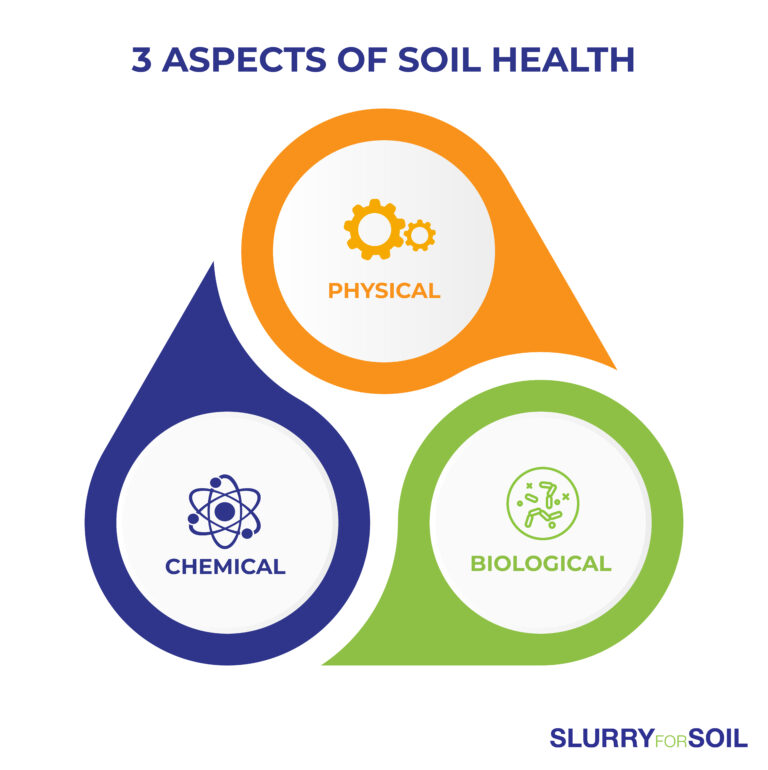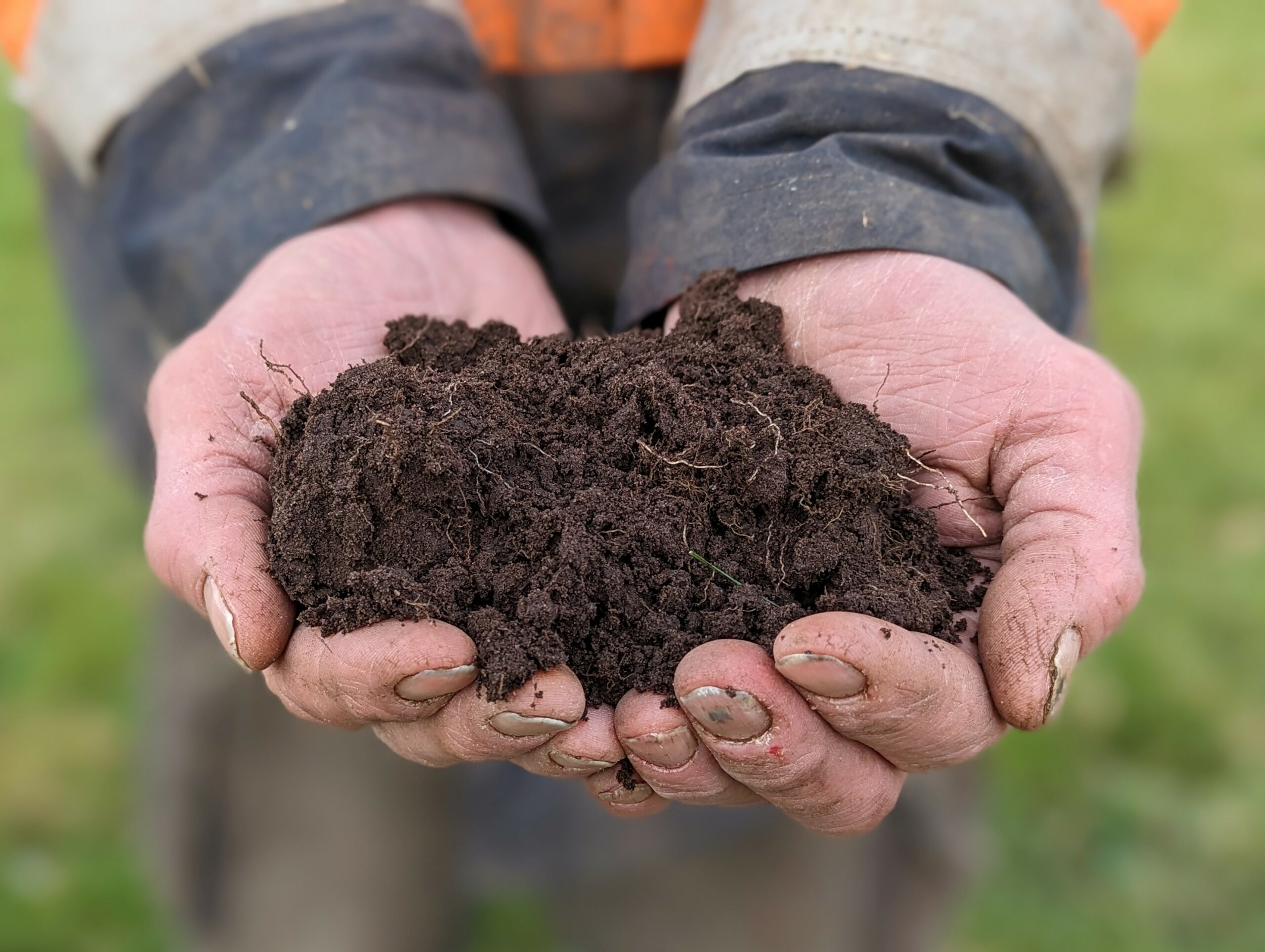Defining ‘soil’ is fairly straightforward. It is a combination of minerals e.g. sand, silt and clay, together with air, water and organic matter. A ‘healthy’ soil, however, is harder to pinpoint and differs upon context and function, as well as the soil’s physical, chemical and biological make-up.
Making the effort to understand the health of soils, often proves worthwhile as healthier soils produce more forage, are more resilient (enabling animals to be out for longer), and require fewer inputs such as nutrients and crop protection products.
CONTEXT OF SOILS
There are over 700 soil types in the UK, each with different properties, reflecting the substrate (the underlying rocks) from which they are made. Soil type will influence the physical and chemical nature of soil. For example, soils born from sandstone will have a sandy texture, and are naturally free draining as sand particles are relatively large (2-0.05mm, compared with 0.05-0.02mm for silt and less than 0.002mm for clay), so the gaps between the soil particles are bigger making it easier for water to flow through.
It’s why, when you’re thinking about soil health it’s important to recognise the ratio of sand, silt and clay, as well as other contextual factors such as the depth of the soil and the local climate. It will help determine the parameters of ‘health’ – we cannot expect a sandy soil to have the same organic matter levels as a peatland, for instance.
FUNCTION OF SOILS
As farmers we’re increasingly facing pressure to further production and lower costs, while reducing our environmental impact. It’s driving us to demand more from our soils. This usually includes:
- producing high quality and quantity of grass for grazing
- producing high quality and quantity of grass for silage making
- controlling the flow of water to mitigate against flood, yet store water for times of drought
- capturing atmospheric carbon
- storing carbon
- supporting biodiversity
Thinking about what you want your soil to do and how well it is currently performing, within its broader context is what soil health is all about.

THE 3 ASPECTS OF SOIL HEALTH - #1 PHYSICAL
The physical, chemical and biological aspects of soil determine how well a soil can perform the desired functions within its unique context. They are tightly interconnected, which means that if one is undermined, the others will be too.
When we’re talking about the physical aspects of soil health, predominantly it’s about aggregation – how the soil is held together – and the spaces between aggregates. Both are important. Soil particles need to be held together tightly enough to prevent erosion by wind and water, but not so tightly that water, air and plant roots struggle to penetrate the soil’s profile.
In livestock farming, compaction is the biggest threat to the physical health of soils.
THE 3 ASPECTS OF SOIL HEALTH - #2 CHEMICAL
Soil chemistry includes pH, cation exchange capacity and the nutrient status. The first two influence how nutrients are held onto the soil particles. Acidic soils (with a low pH) struggle with maintaining major nutrients such as nitrogen, phosphorous and potassium, while alkaline soils (with a high pH) tend to be low in trace elements like manganese, copper and zinc.
The cation exchange capacity describes the ability of a soil to retain positively charged nutrients. Clay and organic matter are negatively charged and ‘hang on’ to these nutrients, albeit relatively loosely. A plant root, or water with a lower concentration of these nutrients, passes and takes the ions away from the clay and organic matter. That is why a soil with a low cation exchange capacity is prone to leaching nutrients – it doesn’t ‘hold on’ to the nutrients and they are washed away with rainfall.
The nutrient status tells us whether a soil contains the basic compounds plants need to grow. Knowing the nutrient status of your soils is really useful and particularly important where you’re regularly applying organic manures and slurry. Understanding the nutrient status can prevent unnecessary spending on synthetic fertiliser and leaching.
THE 3 ASPECTS OF SOIL HEALTH - #3 BIOLOGY
Finally, there’s soil biology. Did you know that there are more organisms in a teaspoon of soil than there are people on the planet?
There are many trophic levels within soil biology from the macro-organisms like moles and earthworms, to the mesofauna such as the nematodes, protozoa and mites, and the microbiology – the bacteria and fungi. All contribute to the healthy functioning of soil.
Soil biology and structure
It tends to be the microbiology – the bacteria and fungi – that work with plants and aggregate soils. They produce ‘sticky’ substances that helps to bind soil particles together. Fungi’s hyphae network also enmesh soil particles, holding them together.
It is the size of the gaps that determines a soil’s water holding capacity. Those with large gaps between particles e.g. sandy soil with low organic matter, will drain more quickly. As well as these natural gaps between aggregates, creatures like earthworms and moles create channels by burrowing through soils. These channels help with the flow of water and air, as well as creating easy paths for plant roots to follow.
Soil biology and plant nutrients
Probably the most significant role of soil biology is in their ability to help plants access nutrients. Some of the soil microbes excrete enzymes in order to convert complex carbon compounds into simpler ones. Other organisms consume organic matter and the breakdown occurs inside of the organism. Death and decay of these organisms, together with predation also contribute to the process.
Some fungi, known as arbuscual mycorrhiza fungi, form symbiotic relationships with plants, exchanging carbon (in the form of sugar, known as ‘exudates’) excreted from roots, for water and dissolved minerals that the plant can use. Hormones, enzymes and proteins are also released by the microbes, some of which trigger a defensive reaction (known as ‘Induced Systemic Resistance’) from the plants which also protect them from other pathogens such as pests and diseases.
It’s a relationship thought to date back some 400 million years, pre-dating the dinosaurs, and is extensive. One gram of grassland soil may contain as much as 100m of arbuscual mycorrhiza hyphae.
Fungi are really important in extending root systems so plants can access more nutrients and water.
Soil biology's other functions
As well as being essential in regulating the flow of water and enhancing plants’ access to nutrients, some soil microbes have been shown to be bio-remedial. They can breakdown substances that would otherwise be toxic to plants.
Soil biology is also part of the ‘carbon sink’ – all those organisms from the plants to the microbes and macrobes are carbon-based lifeforms. Every cell is made from carbon. So the more soil biology there is, the more carbon is captured in the ecosystem.
IS YOUR SOIL HEALTHY?
Bearing in mind the context of your soil (it’s ratio of sand, silt and clay, the climate etc), is it doing what you want it to?
While soil health is complex with many interactions between its components, there are some simple measurements which provide a good indication of where any problems lie.
You can get a good idea of the physical health by simply digging a soil pit and taking a look at the soil profile. You can test for organic matter, pH and nutrient status, as well as counting earthworms. For more information about soil health and measuring it, click here.

